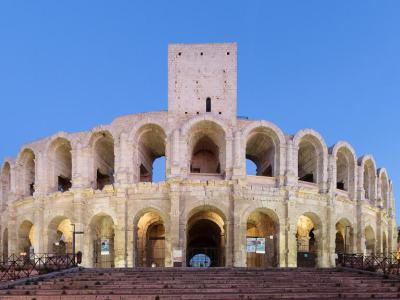
Arenes d'Arles (Arles Amphitheatre), Arles (must see)
The Arles Amphitheatre, is a remarkable Roman amphitheatre located in the picturesque town of Arles This magnificent structure, built in 90 AD, stands as a testament to the grandeur and legacy of Ancient Rome. With its impressive architecture and historical significance, the Arles Amphitheatre has become one of the most prominent tourist attractions in the city.
The amphitheatre is a two-tiered structure that could accommodate more than 20,000 spectators during its prime. It served as a venue for various events, including chariot races and brutal hand-to-hand battles that enthralled the ancient crowds. The sheer scale of the amphitheatre and its ability to host such grand spectacles speaks volumes about the cultural and social significance of the city of Arles during the Roman era.
While the Arles Amphitheatre's origins lie in the Roman period, it underwent modifications in the medieval era. The towers that protrude from the top of the structure are notable medieval additions. These towers, though not original to the Roman construction, add a unique character to the amphitheatre, blending Roman and medieval architectural elements.
In recent times, the amphitheatre continues to captivate visitors with its historical charm. While it no longer hosts large-scale events like chariot races, the Arles Amphitheatre remains an active venue for cultural performances. It has become a popular site for bullfighting during the Feria d'Arles, a traditional festival held annually. Additionally, during the summer months, the amphitheatre provides a remarkable backdrop for plays, concerts, and other artistic events, attracting both locals and tourists alike.
Recognizing its outstanding cultural value, the Arles Amphitheatre was designated as a UNESCO World Heritage Site in 1981. It was included as part of the "Arles, Roman, and Romanesque Monuments" group, which encompasses a collection of Roman and medieval buildings in the city. This prestigious recognition further solidifies the significance of the amphitheatre and highlights its importance in preserving and promoting world history and heritage.
The amphitheatre is a two-tiered structure that could accommodate more than 20,000 spectators during its prime. It served as a venue for various events, including chariot races and brutal hand-to-hand battles that enthralled the ancient crowds. The sheer scale of the amphitheatre and its ability to host such grand spectacles speaks volumes about the cultural and social significance of the city of Arles during the Roman era.
While the Arles Amphitheatre's origins lie in the Roman period, it underwent modifications in the medieval era. The towers that protrude from the top of the structure are notable medieval additions. These towers, though not original to the Roman construction, add a unique character to the amphitheatre, blending Roman and medieval architectural elements.
In recent times, the amphitheatre continues to captivate visitors with its historical charm. While it no longer hosts large-scale events like chariot races, the Arles Amphitheatre remains an active venue for cultural performances. It has become a popular site for bullfighting during the Feria d'Arles, a traditional festival held annually. Additionally, during the summer months, the amphitheatre provides a remarkable backdrop for plays, concerts, and other artistic events, attracting both locals and tourists alike.
Recognizing its outstanding cultural value, the Arles Amphitheatre was designated as a UNESCO World Heritage Site in 1981. It was included as part of the "Arles, Roman, and Romanesque Monuments" group, which encompasses a collection of Roman and medieval buildings in the city. This prestigious recognition further solidifies the significance of the amphitheatre and highlights its importance in preserving and promoting world history and heritage.
Want to visit this sight? Check out these Self-Guided Walking Tours in Arles. Alternatively, you can download the mobile app "GPSmyCity: Walks in 1K+ Cities" from Apple App Store or Google Play Store. The app turns your mobile device to a personal tour guide and it works offline, so no data plan is needed when traveling abroad.
Arenes d'Arles (Arles Amphitheatre) on Map
Sight Name: Arenes d'Arles (Arles Amphitheatre)
Sight Location: Arles, France (See walking tours in Arles)
Sight Type: Attraction/Landmark
Guide(s) Containing This Sight:
Sight Location: Arles, France (See walking tours in Arles)
Sight Type: Attraction/Landmark
Guide(s) Containing This Sight:
Walking Tours in Arles, France
Create Your Own Walk in Arles
Creating your own self-guided walk in Arles is easy and fun. Choose the city attractions that you want to see and a walk route map will be created just for you. You can even set your hotel as the start point of the walk.
Arles Introduction Walking Tour
In the heart of Provence, lies the picturesque town of Arles. Thanks to its relaxing southern-French atmosphere, Arles is a pleasant place to explore. Here, apart from the distinctive Provencal character and small-town charm, you will find a wealth of historical sites.
The Ligurians settled in the area around 800 BC. Later, the Phoenicians established here a trading port, before it was taken... view more
Tour Duration: 1 Hour(s)
Travel Distance: 1.3 Km or 0.8 Miles
The Ligurians settled in the area around 800 BC. Later, the Phoenicians established here a trading port, before it was taken... view more
Tour Duration: 1 Hour(s)
Travel Distance: 1.3 Km or 0.8 Miles
Vincent van Gogh Walking Tour
"There's no place quite like it for painters. It's so beautiful and peaceful..." These words, reportedly attributed to Vincent van Gogh, emphasize the beauty and exceptional qualities of Arles with which the renowned Dutch painter had a special connection.
Vincent van Gogh moved to this town in 1888, after having worked in Paris for two years. In the late 19th century,... view more
Tour Duration: 1 Hour(s)
Travel Distance: 2.1 Km or 1.3 Miles
Vincent van Gogh moved to this town in 1888, after having worked in Paris for two years. In the late 19th century,... view more
Tour Duration: 1 Hour(s)
Travel Distance: 2.1 Km or 1.3 Miles


